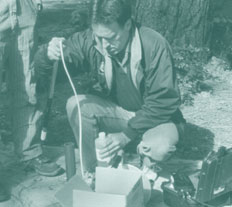
|
Keeping good records - the key to well maintenance
Whether it's a well, a car or a nuclear plant, regular monitoring and record keeping are essential for smooth performance, now and in the future. For most wells, an annual check of specific capacity should be enough to determine their condition.
The specific capacity is the well's rate of production divided by its drawdown. To determine specific capacity follow these steps:
1) With the pump turned off, record the well's static water level (SWL) when the well water is stabilized.
2) Begin pumping at the normal pumping rate and check the pumping rate in gallons per minute (GPM).
3) At the end of about 60 minutes, record the well's pumping water level (PWL) and recheck the pumping rate in gallons per minute (GPM).
4) Subtract SWL from PWL. This is the drawdown (DD).
5) Divide the average GPM by DD. This is the specific capacity (SC).
To summarize:
GPM/(PWL-SWL) = SC
Footage measurements should be taken from the top of the casing (TC) or some other consistent, fixed point and recorded. Northwest Hydro-Fracturing can assist in more detailed evaluation, based on your specific conditions.
To determine if hydro-fracturing is right for
your well, contact us today!
509-466-5078 · 800-368-0998
Email: djminden@msn.com
Scott Graphics © 2018 All Rights Reserved
